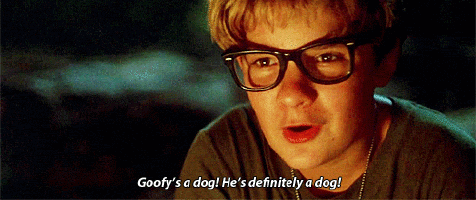Goofy is a dog.
For in-depth analysis like this, consider supporting my Patreon or Ko-fi!
. . . No, huh?
Okay. Obviously, Goofy got his start in “Mickey’s Revue” as Dippy Dawg. Which means he’s a dog. He was Dippy Dawg in his first six shorts. In his seventh, “Orphan’s Benefit,” he was officially Goofy. His appearance shifted several times in those first few years; he was an old anthropomorphized being in “Mickey’s Revue,” older than he’s been in pretty much any of his other appearances. He’s shaggier than usual then, too. The grasshopper in “The Grasshopper and the Ants” more closely resembled Goofy, which is doubtless why “The World Owes Me a Living” became his theme.
By 1935, he’d settled into himself. He began routinely appearing with Mickey and Donald in adventures. Together, the trio hunted ghosts, went to Hawaii, and did their take on “Jack and the Beanstalk.” Later, with just Donald, he’d do such things as get lost in the desert and play at Tarzan type-hunted-by-big game hunter. Then over the years, he’d start appearing in shorts where everyone looked kind of like him, including at least one where no one is actually him. In short, he slowly became one of the most recognized characters in animation.
Why, then, can no one remember he’s a dog? The first question, at least to me, is, “Who doesn’t know that?” Oh, sure, there’s the debate in Stand By Me, but I’m not sure I myself ever had any uncertainty. Yeah, fine, I probably saw “Mickey’s Revue” at an impressionable age, probably including at least once with tedious pontification from George Plimpton. He looks more like a dog than Pete looks like a cat, and arguably as much as Mickey looks like a mouse. In fact, I’ve probably just shocked several of you by mentioning so casually that Pete is a cat.
Oh, Chuck Jones himself observed that funny cartoon animals don’t reliably look much like real animals. Some more than others; his example of the greatest gap between cartoon character and animal it’s supposed to be is the Tasmanian Devil. Because that is a heck of a gap, and honestly Warners characters tend to more closely resemble the animals they’re based on, with the obvious exception there. But as far as the distance goes, Goofy does have some distinctly canine features even during his George Geef years.
And Stand By Me, or its source material “The Body,” is set firmly in the George Geef years. Whether it was set in 1959 or 1960 depends on which you’re talking about, but either way, it was definitely in the years where Goofy was a suburban father. His son didn’t have dog ears; his buck teeth were almost always gone, and his ears were usually hidden. It wouldn’t surprise me to learn that the conversation is one that Rob Reiner (born 1947) and Stephen King (ditto) had with their friends when they were twelve or thirteen. Still, I should think that they would have had exposure to the earlier shorts, at very least on the episodes of The Wonderful World of Disney that I saw as a child myself.
Honestly I imagine lots of kids watching the movie and thinking, “Hey, yeah!” When they’ve known all along what Goofy is, because he’s a dog, and why is this a conversation? I mean, that’s a conversation set at the age where you could say you could eat nothing but cherry-flavoured Pez for the rest of your life. Kids that age up way later than they usually are have many things in common with stoned college students, and one of them is thinking they’re deeper than they really are.
There is one other thing, though, which is worth bringing up. Namely Pluto. It’s not that Goofy wears a hat and drives a car; so does Donald, and no one disputes he’s a duck. It’s very much that Mickey has a pet dog and a friend who’s a dog and that’s weird. There’s a reason Donald did cartoons alone with Pluto and Goofy didn’t. You’d have to think about the logistics of Goofy and Pluto together. People forget Pete’s a cat because he hasn’t looked like one since the ’20s, not because Minnie did a few cartoons with Figaro. But I think Pluto really does change how people see Goofy, even if they basically have the same nose.

